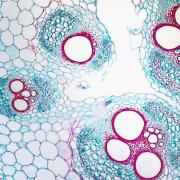Sometimes our bodies need a boost. Millions of Americans rely on pacemakers—small devices that regulate the electrical impulses of the heart in order to keep it beating smoothly. But to reduce complications, researchers would like to make these devices even smaller and less intrusive.
A team of researchers with the University of Chicago has developed a wireless device, powered by light, that can be implanted to regulate cardiovascular or neural activity in the body. The featherlight membranes, thinner than a human hair, can be inserted with minimally invasive surgery and contain no moving parts.
Published Feb. 21 in Nature, the results could help reduce complications in heart surgery and offer new horizons for future devices.
“The early experiments have been very successful, and we’re really hopeful about the future for this translational technology,” said Pengju Li, a graduate student at the University of Chicago Pritzker School of Molecular Engineering and first author on the paper.
‘A new frontier’
The laboratory of Prof. Bozhi Tian has been developing devices for years that can use technology similar to solar cells to stimulate the body. Photovoltaics are attractive for this purpose because they do not have moving parts or wires that can break down or become intrusive—especially useful in delicate tissues like the heart. And instead of a battery, researchers simply implant a tiny optic fiber alongside to provide power.
But for the best results, the scientists had to tweak the system to work for biological purposes, rather than how solar cells are usually designed.
“In a solar cell, you want to collect as much sunlight as possible and move that energy along the cell no matter what part of the panel is struck,” explained Li. “But for this application, you want to be able to shine a light at a very localized area and activate only that one area.”
For example, a common heart therapy is known as cardiac resynchronization therapy, where different parts of the heart are brought back into sync with precisely timed charges. In current therapies, that’s achieved with wires, which can have their own complications.
Li and the team set out to create a photovoltaic material that would only activate exactly where the light struck.
The eventual design they settled on has two layers of a silicon material known as P-type, which respond to light by creating electrical charge. The top layer has many tiny holes—a condition known as nanoporosity—which boost the electrical performance and concentrate electricity without allowing it to spread.
The result is a miniscule, flexible membrane, which can be inserted into the body via a tiny tube along with an optic fiber—a minimally invasive surgery. The optic fiber lights up in a precise pattern, which the membrane picks up and turns into electrical impulses.
The membrane is just a single micrometer thin—about 100 times smaller than the finest human hair—and a few centimeters square. It weighs less than one fiftieth of a gram; significantly less than current state-of-the-art pacemakers, which weigh at least five grams. “The more lightweight a device is, the more comfortable it typically is for patients,” said Li.
This particular version of the device is meant for temporary use. Instead of another invasive surgery to remove the pacemaker, it simply dissolves over time into a nontoxic compound known as silicic acid. However, the researchers said that the devices could be engineered to last to different desired lifespans, depending on how long the heart stimulation is desired.
“This advancement is a game-changer in cardiac resynchronization therapy,” said Narutoshi Hibino, professor of surgery at the University of Chicago Medicine and co-corresponding author on the study. “We're at the cusp of a new frontier where bioelectronics can seamlessly integrate with the body's natural functions.”
Light use
Though the first trials were conducted with heart tissue, the team said the approach could be used for neuromodulation as well—stimulating nerves in movement disorders like Parkinson’s, for example, or to treat chronic pain or other disorders. Li coined the term ‘photoelectroceuticals’ for the field.
Tian said the day when they first tried the pacemaker in trials with pig hearts, which are very similar to those of humans, remains vivid in his memory. “I remember that day because it worked in the very first trial,” he said. “It's both a miraculous achievement and a reward for our extensive efforts.”
A screening method developed by Li to map the photoelectrochemical output of various silicon-based materials could also have uses elsewhere, Tian pointed out, such as in fields like new battery technologies, catalysts, or photovoltaic cells.
The research team is currently working with the UChicago Polsky Center for Entrepreneurship and Innovation to commercialize the device.
The other UChicago authors on the paper were Jing Zhang, Hidenori Hayashi, Jiping Yue, Wen Li, Chuanwang Yang, Changxu Sun, Jiuyun Shi, and Judah Huberman-Shlaes. The research made us of the Pritzker Nanofabrication Facility at the UChicago Pritzker School of Molecular Engineering and the Electron Microscopy Service of the University of Illinois Chicago Research Resources Center.
Citation: “Monolithic silicon for high spatiotemporal translational photostimulation.” Li et al, Nature, Feb. 21, 2024.
Funding: National Institutes of Health, U.S. Air Force Office of Scientific Research, National Science Foundation, U.S. Army Research Office.

